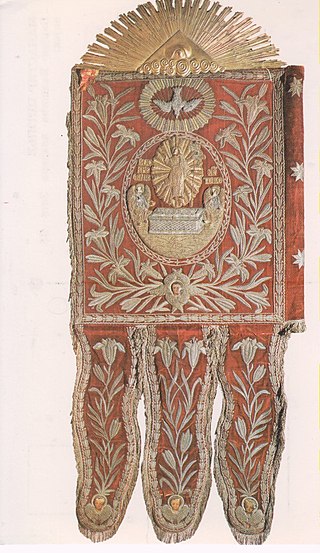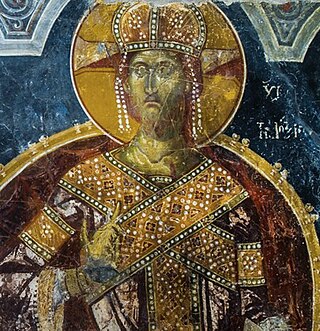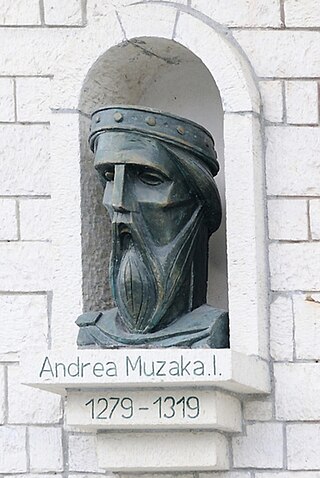
Balša Balšić died September 18, 1385) or Balša II was the Lord of Lower Zeta from 1378 to 1385. He was a member of the Balšić noble family, which ruled Zeta from ca. 1362 to 1421.
The Battle of Savra or the Battle of the Vjosë was fought on 18 September 1385 between Ottoman and much smaller Zetan forces, at the Savra field near Lushnjë. The Ottomans were invited by Karl Thopia to support him in his feud against Balsha II.

Hélène of Anjou, was a member of the House of Anjou. She was an illegitimate daughter of Robert, King of Naples.

The Principality of Muzaka, also known as the Lordship of Berat, was an independent realm ruled by the Albanian Muzaka family with its capital at Berat, covering territories in Central and Southern Albania, Western Macedonia and Northern Greece. One of the first rulers was Andrea I Muzaka whose reign was recognized by the Byzantine Emperor. During the Battle of Savra, the Ottomans captured Berat from Balša II, together with Kruja and Ulcinj. They soon retreated from all of those towns keeping only Castoria under their permanent control. Some sources explain that Ottomans probably remained in Berat with intention to use it as foothold to capture Valona. By 1396 Muzaka family took over control of Berat. In 1417 the territories of the Principality, including Vlorë and Berat, became a part of the Ottoman Empire.

John Zenevisi or Gjon Zenebishi was an Albanian magnate that held the estates in Epirus, such as Gjirokastër and Vagenetia.

Gjon Muzaka was an Albanian nobleman from the Muzaka family, that has historically ruled in the Myzeqe region, Albania. In 1510 he wrote the Muzaka chronicles (a Breve memoria de li discendenti de nostra casa Musachi. The work was published in Karl Hopf's Chroniques gréco-romaines, Paris 1873, pp. 270–340.

The Muzaka family was an noble Albanian family that ruled over the region of Myzeqe in the Late Middle Ages. The Muzaka are also referred to by some authors as a tribe or a clan. The earliest historical document that mentions the Muzaka family is written by the Byzantine historian Anna Komnene. At the end of the 13th and beginning of the 14th century members of the Muzaka family controlled a region between the rivers of Devoll and Vjosë. Some of them were loyal to the Byzantine Empire while some of them allied with Charles of Anjou who gave them impressive Byzantine-like titles in order to subdue them more easily. In the 1340s, Stefan Dušan pressed further south into Albania, and by 1343-45 had taken central towns and territories in southern Albania, including domains of the Muzaka family. However, they would fall back under local control after his death in 1355. After the Battle of Savra in 1385 the territory of Albania came under the Ottoman Empire; they served the Ottomans until 1444 when Theodor Corona Musachi joined Skanderbeg's rebellion. When the Ottomans suppressed Skanderbeg's rebellion and captured the territory of Venetian Albania in the 15th century many members of the Muzaka family retreated to Italy. Those who stayed in Ottoman Albania lost their feudal rights, some converted to Islam and achieved high ranks in the Ottoman military and administrative hierarchy.

Teodor II Muzaka, was an Albanian Prince from the House of Muzaka, he was the Lord of Berat and Lord of Myzeqe.

Teodor I Muzaka was an Albanian nobleman that ruled the Lordship of Berat between 1319 and 1331. According to John Musachi, he had the nickname "këshetesi", meaning the one with braided hair. He had a brother Count Mentula Muzaka of Clissura or today called Kelcyra.

John Komnenos Asen was the ruler of the Principality of Vlorë from c. 1345 to 1363, initially as a vassal of the Serbian Empire, and after 1355 as a largely independent lord. Descended from high-ranking Bulgarian nobility, John was a brother of both Tsar Ivan Alexander of Bulgaria and Helena of Bulgaria, the wife of Tsar Stephen Dušan of Serbia. Perhaps in search of better opportunities, he emigrated to Serbia, where his sister was married. There, he was granted the title of despot by Stephen Dušan, who placed him in charge of his territories in modern south Albania.

The Thopia were one of the most powerful Albanian feudal families in the Late Middle Ages, part of the nobility of the Angevin Kingdom of Albania.

Theodor Corona Musachi or Teodor III Korona Muzaka, was an Albanian nobleman who led the 1437–38 revolt against the Ottomans and was one of the founders of the League of Lezhë in 1444.

Andrea I Muzaka was an Albanian prince of the Muzaka family and the ruler of the Principality of Muzaka.

Stoya Muzaka, also known as Stoja Muzaka, was an Albanian nobleman, the Lord of Kastoria, and a member of the influential Albanian Muzaka family, which played a significant role in ruling parts of Southern Albania and Epirus.

Gjin I Muzaka, was an Albanian Prince from the House of Muzaka. He held the majority of his father's holdings after his father's death and was the Lord of Tomorniza. As well as the Lord of Kastoria after his younger brother Stoya Muzaka died after 1384 leaving no heirs.

Euphemia Mataranga, also known as Euthymia, Eythvmia, Etinia or Onorata was an Albanian noblewoman and member of the Mataranga family.

Chiranna Muzaka, also known as Kyranna or Anne was an Albanian princess and member of the Muzaka family.

Comita Muzaka, also known as Komnena or Komnene was an Albanian princess and member of the Muzaka family.
The Muzaka Chronicles also known as the Memoire of Gjon Muzaka was a Chronicle written by Albanian nobleman Gjon Muzaka of the noble Muzaka family from Albania. It was written in 1510 during the late Middle Ages. It contains important information about the history of Albania as well as a glimpse into the life and reign of Albanian nobility.

Paul Mataranga, also known as Paul Matarango or Paolo Matarango was an Albanian Lord and member of the Mataranga family.

















